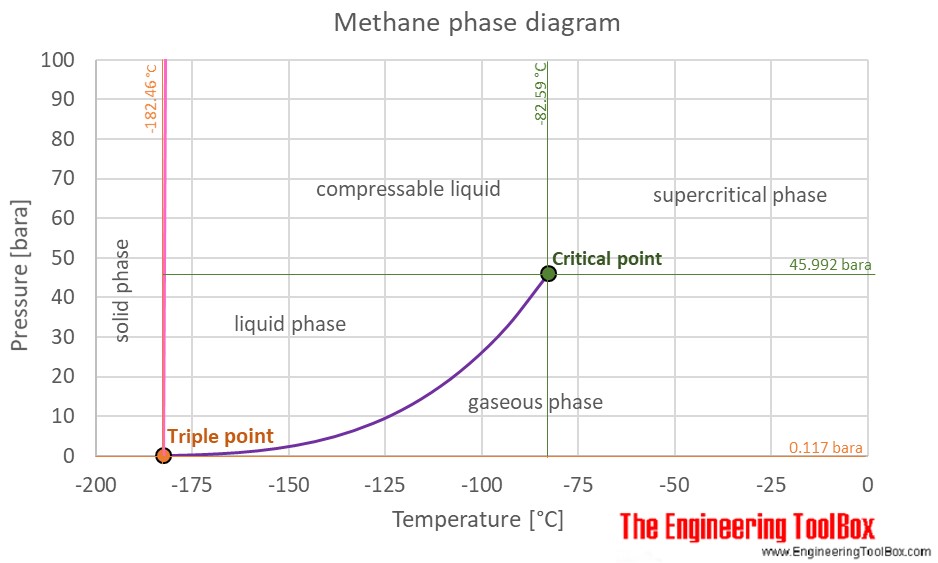Methane (CH₄): Thermophysical Properties and Phase Diagram
Chemical, Physical and Thermal Properties of Methane - CH4. Phase diagram included.
Methane, CH4 , is a colorless odorless gas. It is also known as marsh gas or methyl hydride. The vapors are lighter than air.
Methane is easily ignited. Under prolonged exposure to fire or intense heat the containers may rupture violently and rocket.
Methane is used as feed stock to chemical industry and is the main constituent of the fuel natural gas .
Chemical, physical and thermal properties of methane:
Values are given for gas phase at 25 °C (77 °F, 298 K) and 1 atm., if not other phase, temperature or pressure given.
For full table with Imperial Units - rotate the screen!
| Property | Value | Unit | Value | Unit | Value | Unit | Value | Unit | |||
|---|---|---|---|---|---|---|---|---|---|---|---|
| Autoignition temperature | 810 | K | 537 | °C | 999 | °F | |||||
| Boiling Point | 111.51 | K | -161.6 | °C | -259.0 | °F | |||||
| Critical density | 10.139 | mol/dm3 | 162.7 | kg/m3 | 0.3156 | slug/ft3 | 10.15 | lb/ft3 | |||
| Critical Pressure | 4.5992 | MPa=MN/m2 | 45.99 | bar | 45.39 | atm | 667.1 | psi=lbf/in2 | |||
| Critical Temperature | 190.56 | K | -82.59 | °C | -116.66 | °F | |||||
| Critical Volume | 98.63 | cm3/mol | 0.00615 | m3/kg | 3.169 | ft3/slug | 0.0985 | ft3/lb | |||
| Density, gas | 41.0 | mol/m3 | 0.657 | kg/m3 | 0.00127 | slug/ft3 | 0.0410 | lb/ft3 | |||
| Density, gas at STP; 32°F/0°C 1 atm | 44.7 | mol/m3 | 0.7168 | kg/m3 | 0.00139 | slug/ft3 | 0.0447 | lb/ft3 | |||
| Density, liquid at -260 °F/-162°C | 26429 | mol/m3 | 422.6 | kg/m3 | 0.820 | slug/ft3 | 26.38 | lb/ft3 | |||
| Flammable, gas and liquid | yes | ||||||||||
| Flash point | 85 | K | -188 | °C | -306 | °F | |||||
| Gas constant - R | 518.28 | J/kg K | 0.1440 | Wh/(kg K) | 3099 | (ft lbf/slug °R) | 96.329 | (ft lbf/lb °R) | |||
| Gibbs free energy of formation | -51 | kJ/mol | -3179 | kJ/kg | -1367 | Btu/lb | |||||
| Heat (latent) of vaporation | 8.19 | kJ/mol | 511 | kJ/kg | 219.48 | Btu/lb | |||||
| Specific heat, Cp | 35.8 | J/mol K | 2.232 | kJ/kg K | 0.533 | Btu/lb°F or cal/g K | |||||
| Specific Heat, Cv | 27.4 | J/mol K | 1.709 | kJ/kg K | 0.408 | Btu/lb°F or cal/g K | |||||
| Heat of combustion | -890.8 | kJ/mol | -55528 | kJ/kg | -23.9 | Btu/lb | |||||
| Heat(enthalpy) of formation | -75.00 | kJ/mol | -4675 | kJ/kg | -2010 | Btu/lb | |||||
| log KOW (Octanol/Water Partition Coefficient) | 1.09 | ||||||||||
| Melting point | 90.55 | K | -182.6 | °C | -296.7 | °F | |||||
| Molecular Weight | 16.042 | g/mol | 0.03537 | lb/mol | |||||||
| Solubility in water | 0.022 | mg/ml | |||||||||
| Sound velocity | 446 | m/s | |||||||||
| Specific Gravity (density relativ to air), 0°C/32°F | 0.554 | ||||||||||
| Specific Heat Ratio - Cp/Cv | 1.31 | ||||||||||
| Specific Volume | 0.0244 | m3/mol | 1.52 | m3/kg | 784.44 | ft3/slug | 24.38 | ft3/lb | |||
| Standard molar entropy, S° | 186 | J/mol K | 11.59 | kJ/kg K | 2.77 | Btu/lb °F | |||||
| Surface tension at -161 °C / -258 °F | 14 | dynes/cm | 0.014 | N/m | |||||||
| Thermal Conductivity | 0.0339 | W/m°C | 0.019587 | Btu/hr ft °F | |||||||
| Triple point pressure | 0.011696 | MPa=MN/m2 | 0.117 | bar | 0.115 | atm | 1.70 | psi=lbf/in2 | |||
| Triple point temperature | 90.69 | K | -182.456 | °C | -296.42 | °F | |||||
| Vapor (saturation) pressure | 62.12 | MPa=MN/m2 | 466000 | mm Hg | 613.07 | atm | 9010 | psi=lbf/in2 | |||
| Vapor (saturation) pressure at 38 °C /100 °F | 34.47 | MPa=MN/m2 | 258574 | mm Hg | 340.18 | atm | 4999 | psi=lbf/in2 | |||
| Viscosity, dynamic (absolute) | 0.01107 | cP | 7.44 | (lbm/ft s ×10-6) | 0.23 | (lbf s/ft2 ×10-6) | |||||
| Viscosity, kinematic | 17.08 | cSt | 183.8 | (ft2/s ×10-6) |
Follow the links below to get values for the listed properties of methane at varying pressure and temperature :
- Density and specific weight
- Dynamic and kinematic viscosity
- Prandtl number
- Specific heat (heat capacity)
- Thermal conductivity
See also more about atmospheric pressure, and STP - Standard Temperature and Pressure & NTP - Normal Temperature and Pressure,
as well as Thermophysical properties of: Acetone, Acetylene, Air, Ammonia, Argon, Benzene, Butane, Carbon dioxide, Carbon monoxide, Ethane, Ethanol, Ethylene, Helium, Hydrogen, Hydrogen sulfide, Methanol, Nitrogen, Oxygen, Pentane, Propane, Toluene, Water and Heavy water, D2O.
Methane is a gas at standard conditions. However, at low temperature and/or high pressures the gas becomes a liquid or a solid.
The methane phase diagram shows the phase behavior with changes in temperature and pressure. The curve between the critical point and the triple point shows the methane boiling point with changes in pressure.

At the critical point there is no change of state when pressure is increased or if heat is added.
The triple point of a substance is the temperature and pressure at which the three phases (gas, liquid, and solid) of that substance coexist in thermodynamic equilibrium.



